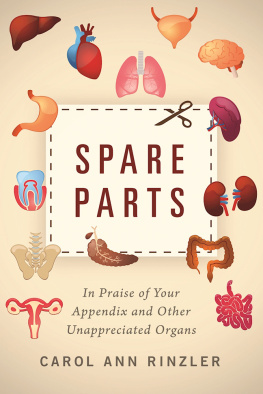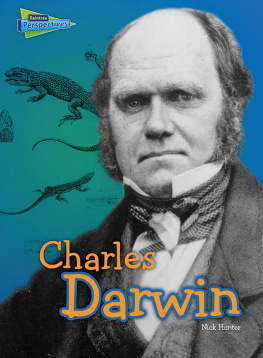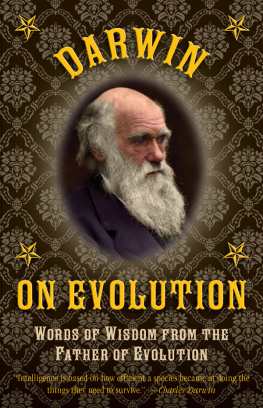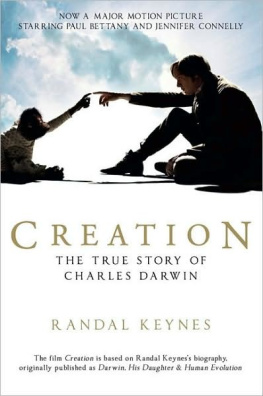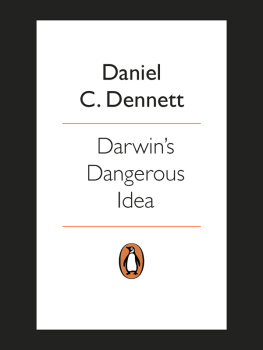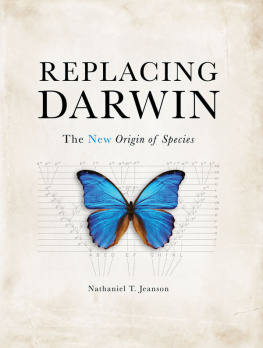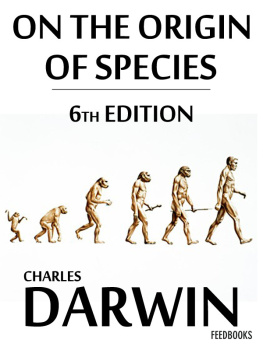Praise for Carol Ann Rinzlers Previous Works
Our reviewer declared that this book represents some of the best writing about science for the nonscientist that he has encountered in recent years.
American Association for the Advancement of Science
Rinzler clearly enjoyed researching her subject and cant stop herself from going on interesting digressions, often bringing up one or two mostly unrelated topics within the course of a paragraph. Shes at her best when discussing medical history and etymology.
Library Journal
Stylish, informative, entertaining, and pleasantly personal maintains a fascinating perspective on the peculiarities of being human.
Rain Taxi Review of Books
Readers often like to walk away from a book feeling they learned somethingthat the author left them with a new way to look at an old idea, and this book fulfills that need.
City Book Review/San Francisco & Sacramento
Copyright 2017 by Carol Ann Rinzler
All rights reserved. No part of this book may be reproduced in any manner without the express written consent of the publisher, except in the case of brief excerpts in critical reviews or articles. All inquiries should be addressed to Skyhorse Publishing, 307 West 36th Street, 11th Floor, New York, NY 10018.
Skyhorse Publishing books may be purchased in bulk at special discounts for sales promotion, corporate gifts, fund-raising, or educational purposes. Special editions can also be created to specifications. For details, contact the Special Sales Department, Skyhorse Publishing, 307 West 36th Street, 11th Floor, New York, NY 10018 or .
Skyhorse and Skyhorse Publishing are registered trademarks of Skyhorse Publishing, Inc., a Delaware corporation.
Visit our website at www.skyhorsepublishing.com.
10 9 8 7 6 5 4 3 2 1
Library of Congress Cataloging-in-Publication Data is available on file.
Cover design by Rain Saukas
Cover images: iStock
Print ISBN: 978-1-5107-1250-8
Ebook ISBN: 978-1-5107-1251-5
Printed in the United States of America
For my resolute agent
Phyllis Westberg,
My creative editor
Michael Lewis,
and
For my husband
Perry Luntz
Always
Table of Contents
Illustrations
Chapter 1:
The Human Intestines, with the Appendix (1a) [Public domain, courtesy of Indolences at the Wikipedia project]
Earliest-known drawing of the appendix, Leonardo da Vinci (1492) (1b) [Public domain]
Chapter 2:
Human Body Hair [Wikimedia Commons, under the terms of GNU Free Documentation License]
Chapter 3:
The Greek & Roman Sea God Triton, Son of Poseidon/Neptune (3a) [Public domain; Wikipedia]
The Similarity among Embryos Illustration from Ernst Heackels Anthropogenie (1874) (3b) (Wikipedia)
Chapter 4:
The Three-Part Ear, Grays Anatomy (4a) [Public domain; Wikimedia commons]
The Outer Ear, Grays Anatomy (4b) [Public domain; Wikimedia commons]
Chapter 5:
The Human Plica Semilunaris Henry Gray, Anatomy of the Human Body [Public domain; Wikimedia commons]
Chapter 6:
Your Canine Teeth (6a), Grays Anatomy [Public domain; Wikimedia commons]
Your Canine Teeth (6b), Grays Anatomy [Public domain; Wikimedia commons]
Introduction
I have been speculating last night what makes a man a discoverer of undiscovered things; and a most perplexing problem it is.
Charles Darwin, A Century of Family Letters, 1792-1896 (ed. John Murray)
T ucked away near the end of Chapter 13 in Charles Darwins first edition of On the Origin of Species by Means of Natural Selection or the Preservation of Favoured Races in the Struggle for Life (1859) is a quiet little list of rudimentary, atrophied or aborted body parts, evidence, perhaps, of how some animals and plants evolved: teeth in embryonic whales, wings for flightless birds, and undeveloped pistils (the female part of a flower) in male flowers. The only human tissue on the list is the mammalian male breast. Twelve years later, in The Descent of Man, and Selection in Relation to Sex (1873), Darwin added six bits and pieces of our bodies: The appendix, our body hair, the coccyx, our outer ear muscles, our third eyelid, and our wisdom teeth.
After that, the race was on to identify unnecessary tissues and organs. By 1893, when German anatomist Robert Wiedersheim published The Structure of Man: An Index to His Past History, he listed a grand total of 86 vestiges , organs once more important to the human body than they presently are. His list included (but was not limited to) valves in veins, the pineal gland, the lachrymal glands, the thymus, the thyroid, a clutch of small bones in the third, fourth, and pinky toes, and, in the full flower of Victorian prudery, the clitoris.
But conclusion jumping is a dangerous sport. In 1859, Charles Darwin labeled the appendix vestigial, and ever since then people have translated that as useless. Contrary to common wisdom, the appendix has been pivotal in the history of medicine. First seen by ancient Egyptian priests preparing the dead, the appendix remained hidden from western eyes for several thousand years, emerging only when autopsy became common and Italian Renaissance artists and anatomists defied the Church prohibition on human dissection to discover what Leonardo da Vinci called the little ear at the junction between the small and large intestine. Once identified, the appendix played a leading role in the development of surgical medicine at the end of the 19th century. Today it figures in our exploration of the gastrointestinal system and our immune function, while pragmatic surgeons have used it to replace a damaged ureter.
There are similar facts attesting to the value of Darwins earlier list of unnecessary body parts. A full set of toes keeps us balanced on our feet. The valves in our veins keep blood from flowing backward. And who doesnt value our hormone-secreting thymus and thyroid, the lachrymal glands that moisten our eyes, and, thanks to Masters, Johnson, and sexually active women, the clitoris?
Nonetheless, the Darwin Six still fascinate.
From the start, Darwins theories and his list of vestiges prompted a passionate debate between strict creationists, who argued that the Designer created the world, from poppies to people, exactly as it is (or was in 1859) and religious liberals, who accepted physical adaptation as part of a Creators plan. The two sides met famously on June 30, 1860, at the Oxford University Museum, when Oxford Archbishop Samuel Wilberforce reputedly demanded of British biologist/anatomist Thomas Huxley whether he was descended from an ape on his grandmothers or grandfathers side. If the question is put to me whether I would rather have a miserable ape for a grandfather or a man highly endowed by nature and possessed of great means of influence and yet employs these faculties and that influence for the mere purpose of introducing ridicule into a grave scientific discussion, Huxley is reported to have said, I unhesitatingly affirm my preference for the ape.
There is some dispute about exactly who said what to whom that evening, but there is no doubt that Darwin the scientist sided with Huxley. Before his marriage, he confided to his prospective bride Emma Wedgewood that he was in the process of rewriting the history of life. That, according to his convictions, all living things descended from a common ancestor. And that species were not to be attributed to Gods endless creativity, but were the product of a blind, mechanical process that altered them over the course of millions of years. Emmas reaction was to implore her betrothed to reread his Bible; she feared his unbelief
Next page
